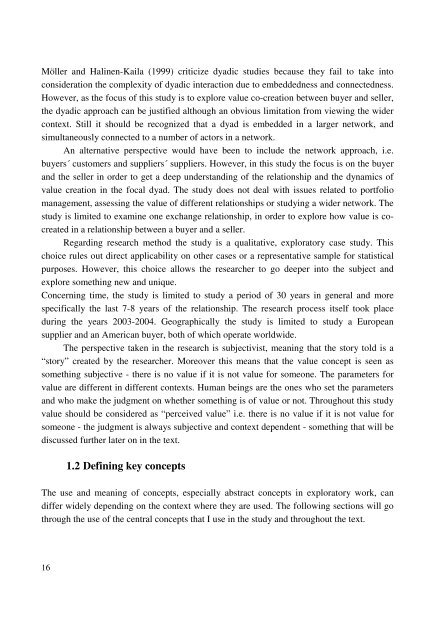Value Co-Creation in Industrial Buyer-Seller Partnerships ... - Doria
Value Co-Creation in Industrial Buyer-Seller Partnerships ... - Doria
Value Co-Creation in Industrial Buyer-Seller Partnerships ... - Doria
- No tags were found...
Create successful ePaper yourself
Turn your PDF publications into a flip-book with our unique Google optimized e-Paper software.
Möller and Hal<strong>in</strong>en-Kaila (1999) criticize dyadic studies because they fail to take <strong>in</strong>toconsideration the complexity of dyadic <strong>in</strong>teraction due to embeddedness and connectedness.However, as the focus of this study is to explore value co-creation between buyer and seller,the dyadic approach can be justified although an obvious limitation from view<strong>in</strong>g the widercontext. Still it should be recognized that a dyad is embedded <strong>in</strong> a larger network, andsimultaneously connected to a number of actors <strong>in</strong> a network.An alternative perspective would have been to <strong>in</strong>clude the network approach, i.e.buyers´ customers and suppliers´ suppliers. However, <strong>in</strong> this study the focus is on the buyerand the seller <strong>in</strong> order to get a deep understand<strong>in</strong>g of the relationship and the dynamics ofvalue creation <strong>in</strong> the focal dyad. The study does not deal with issues related to portfoliomanagement, assess<strong>in</strong>g the value of different relationships or study<strong>in</strong>g a wider network. Thestudy is limited to exam<strong>in</strong>e one exchange relationship, <strong>in</strong> order to explore how value is cocreated<strong>in</strong> a relationship between a buyer and a seller.Regard<strong>in</strong>g research method the study is a qualitative, exploratory case study. Thischoice rules out direct applicability on other cases or a representative sample for statisticalpurposes. However, this choice allows the researcher to go deeper <strong>in</strong>to the subject andexplore someth<strong>in</strong>g new and unique.<strong>Co</strong>ncern<strong>in</strong>g time, the study is limited to study a period of 30 years <strong>in</strong> general and morespecifically the last 7-8 years of the relationship. The research process itself took placedur<strong>in</strong>g the years 2003-2004. Geographically the study is limited to study a Europeansupplier and an American buyer, both of which operate worldwide.The perspective taken <strong>in</strong> the research is subjectivist, mean<strong>in</strong>g that the story told is a“ story” created by the researcher. Moreover this means that the value concept is seen assometh<strong>in</strong>g subjective - there is no value if it is not value for someone. The parameters forvalue are different <strong>in</strong> different contexts. Human be<strong>in</strong>gs are the ones who set the parametersand who make the judgment on whether someth<strong>in</strong>g is of value or not. Throughout this studyvalue should be considered as “ perceived value” i.e. there is no value if it is not value forsomeone - the judgment is always subjective and context dependent - someth<strong>in</strong>g that will bediscussed further later on <strong>in</strong> the text.1.2 Def<strong>in</strong><strong>in</strong>g key conceptsThe use and mean<strong>in</strong>g of concepts, especially abstract concepts <strong>in</strong> exploratory work, candiffer widely depend<strong>in</strong>g on the context where they are used. The follow<strong>in</strong>g sections will gothrough the use of the central concepts that I use <strong>in</strong> the study and throughout the text.16
















